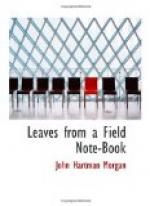PAUL
DUVAL,
151e Reg. d’Inf.
6
sept. 1914
MORT POUR LA PATRIE.
The sun was fast declining over the chalk hills and it grew bitter cold. I unfolded my camera, stepped back eight paces, and pressed the trigger. We clambered back into the car and resumed the road to Meaux. As I looked over my shoulder the last things I saw in the enfolding twilight were those little flags still fluttering wistfully in the wind.
XIII
MEAUX AND SOME BRIGANDS
We lay the night at Meaux. It was a town which breathed the enchantments of the Middle Ages and had for me the intimacy of a personal reminiscence. Sixteen years earlier, when reading for a prize essay at Oxford, I had studied the troubled times of Etienne Marcel in the treasures of the Bibliotheque de l’Ecole des Chartes, and I knew every kilometre of this country as though I had trodden it. Meaux, Compiegne, Senlis—they called to my mind dreamy hours in the dim religious light of muniment-rooms and days of ecstasy among the pages of Froissart. Little did I think when I read those belligerent chronicles in the sequestered alcoves of the Bodleian and the Bibliotheque Nationale, tracing out the warlike dispositions of Charles the Bad and the Dauphin and the Provost of the Merchants, that the day would come when I would be traversing these very fields engaged in detective enterprises upon the footprints of contemporary armies. To compare the variae lectiones of two manuscripts concerning a fourteenth-century skirmish is good, it has all the excitement of the chase; but to be collating the field note-book of a living Hun with the dossier of a contemporary Justice de Paix, this is better. It has all the contact of reality and the breathless joy of the hue and cry. And, after all, were things so very different? Generations come and go, dynasties rise and fall, but the earth endureth for ever, and these very plains and hills and valleys that have witnessed the devastation of the Hun have also seen the ravages of the mercenaries and free companies




